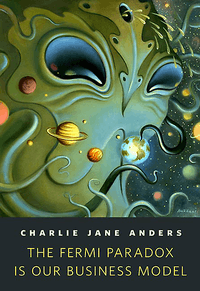The Fermi Paradox Is Our Business Model
| "The Fermi Paradox Is Our Business Model" | |
|---|---|
|
Cover of first edition (ebook) | |
| Author | Charlie Jane Anders |
| Country | United States |
| Language | English |
| Genre(s) | Science fiction short story |
| Published in | Tor.com |
| Publication type | Periodical |
| Publisher | Tor Books |
| Media type | Online magazine |
| Publication date | August 11, 2010 |
"The Fermi Paradox Is Our Business Model" is a science fiction short story by Charlie Jane Anders. It was first published in the online magazine Tor.com August 11, 2010.[1]
Synopsis
An alien agency uses the creation of civilizations and the Fermi Paradox as a means of accumulating and collecting valuable resources.
Their "business model" consists of the following steps:
- Use life-seeding devices to spread basic single-celled life on billions of planets in a target galaxy (i.e. Panspermia)
- Wait millions or billions of years for life to evolve to sentience on several of these planets.
- Individual starships then secretly monitor the radio transmissions of these civilizations, once they develop into a technological society. The crew then goes into stasis for millennia at a time, but are brought out of stasis by automated systems when they detect that radio transmissions have ceased.
- Most industrial civilizations will eventually render themselves extinct through warfare, usually involving weapons of mass destruction (nuclear, biological, etc.) but other times simply overpopulation, depleted resources, and pollution. The progenitor aliens call this "Closure".
- While the civilization flourished, it extracted most of the construction metals, valuable radioactive elements, and other rare or useful resources from within the planet. Once they have killed themselves off, the silently-observing progenitor-aliens then move in and simply collect these already-extracted resources from the surface. On a net level across an entire galaxy, on a scale of millions of years, this is significantly cheaper than sending out automated drones to directly mine for the resources.
It is illegal to outright invade one of the seeded civilizations, and the progenitor aliens must wait for them to drive themselves into extinction without outside interference. The progenitor-aliens do not manipulate the seeded civilization in any way, nor were they genetically designed with a predisposition to kill each other: the progenitors simply discovered that (according to the Fermi Paradox) most industrial civilizations will drive themselves into extinction before developing interstellar spaceflight. The percentage of civilizations that survive to an interstellar stage is actually so astronomically low that out of billions of planets to choose from, a single survey ship might never encounter one.
Two aliens, Jon and Toku, are on their way to a planet called Earth that they assume has met its demise like all the other planets they have visited. However, after waking from stasis, they find that this is not the case.
Reception
Locus Online's Lois Tilton reviewed the short story as "an entertaining story, a neat and original take on a classic SFnal trope."[2] Tangent Online's Duane Donald reviewed it as "a very interesting tale of very long-lived extraterrestrials"[3] but noted it "was over sooner than I would have liked."[3] The short story was selected for Locus's 2010 Recommended Reading List, [4] and Gardner Dozois listed it as an 'honorable mention' for The Year's Best Science Fiction: Twenty-Eighth Annual Collection.[5]
References
- ↑ "The Fermi Paradox Is Our Business Model by Charlie Jane Anders". Tor.com. 11 August 2010. Retrieved 29 September 2011.
- ↑ Lois Tilton (30 August 2010). "Lois Tilton reviews Short Fiction, late August". Locus Online. Retrieved 29 September 2011.
- 1 2 Duane Donald (26 September 2010). "Tor.com -- August 2010". Tangent Online. Retrieved 29 September 2011.
- ↑ "2010 Recommended Reading List". Locus. Retrieved 29 September 2011.
- ↑ The Year's Best Science Fiction: Twenty-Eighth Annual Collection, edited by Gardner Dozois; published 2011 by St. Martin's Griffin; page 653
